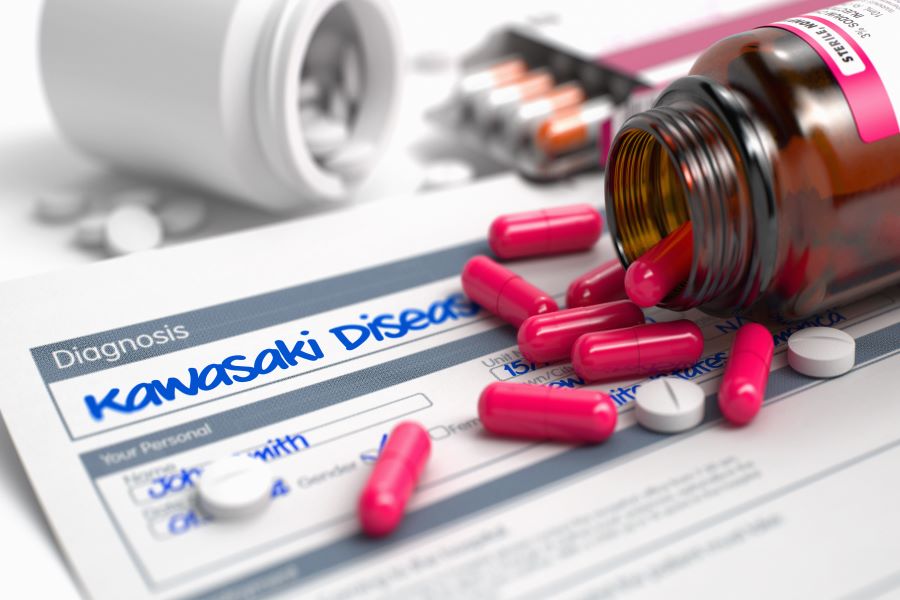What is Kawasaki Disease?

Kawasaki disease (KD) is a disease characterized by fever, rash, enlarged lymph nodes, and involvement of the eyes and lips that most commonly occurs in children under age 5. If left untreated, this serious disease can lead to inflammation of the blood vessels in the heart. Kawasaki disease occurs in about 1 in every 10,000 children under age 5 in the United States.
The name comes from Tomisaku Kawasaki, a Japanese pediatrician who first documented the illness in 1967. It is more common in Japan, and people of East Asian descent are at higher risk. But Kawasaki disease occurs in people of any race or ethnic group. Boys are about twice as likely as girls to develop Kawasaki disease. Adults and children older than 5 can also get Kawasaki disease, but it is rare.
The condition is diagnosed by a pattern of symptoms and by ruling out other possible causes. Symptoms of Kawasaki disease may include:
- A persistent fever lasting at least 5 days.
- A rash on the back, chest, and/or stomach (or in the groin of infants).
- Swollen lymph nodes in the neck.
- Red eyes that may be sensitive to light.
- “Strawberry tongue”—very red, slightly swollen tongue with a coating that may slough off. The inside of the mouth may also be red, and lips may be dry and cracked.
- Red, swollen palms of hands and soles of feet.
After a week or two, other symptoms may develop, such as peeling skin, joint pain, abdominal pain, and diarrhea. This is sometimes called the second phase of Kawasaki disease.
There is no single test to diagnose Kawasaki disease. Typically, markers of inflammation in the blood are elevated, giving doctors clues that point to the disease. Also, an abnormal echocardiogram in conjunction with some of these symptoms also helps to point to the diagnosis. Similar symptoms can also be seen in certain viral infections, however, so the diagnosis is unclear at times. Finally, not everyone with Kawasaki disease has all of these symptoms, so sometimes the diagnosis is not clear right away. If some of the features are absent, it is referred to as atypical Kawasaki disease.
The main concern with Kawasaki disease is that it can lead to an inflammation of blood vessels, called vasculitis. This inflammation is most dangerous when it affects the blood vessels in and around the heart. Blood vessel inflammation can weaken or damage the coronary arteries that supply the heart with oxygen-rich blood, or even the heart itself. Weakened arteries can also lead to a bulging of the artery wall (aneurysm) or heart-rhythm problems (arrhythmias). Typically patients with Kawasaki disease will have an echocardiogram performed to see if they have developed coronary changes.
Treatment for Kawasaki disease involves a hospital stay. A medication called IVIG (intravenous immunoglobulin) is typically used to treat the disease in an attempt to prevent heart-related problems. Most kids return to normal activities once the main illness has passed, although some symptoms (like peeling skin) might continue for a while longer. Follow-up visits with a cardiologist are important to make sure no heart-related problems occur down the road that didn’t show up right away.
The cause of Kawasaki disease is not known, and therefore there is no way to prevent it. But early detection and treatment is effective at preventing heart-related complications. Kawasaki disease does not appear to be contagious. But the condition can run in families, according to the National Library of Medicine’s Genetics Home Reference. Children of parents who’ve had the disease are twice as likely to get it themselves. And siblings of affected children are 10 times more likely to get Kawasaki disease at some point than the general population.
Sources:
- American Heart Association
- Kawasaki Disease.
Genetics Home Reference, US National Library of Medicine - Kawasaki Disease.
Kawasaki Disease Foundation - What is Kawasaki Disease?
KidsHealth.org - Kawasaki Disease.
Powered by Bundoo®










